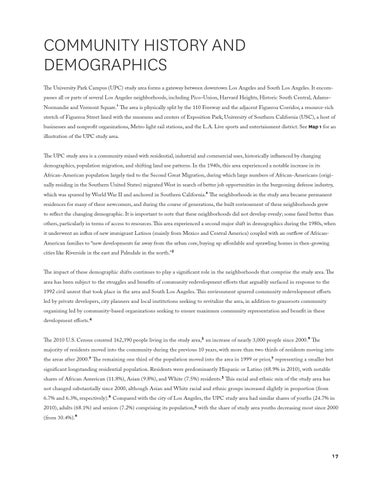COMMUNITY HISTORY AND DEMOGRAPHICS The University Park Campus (UPC) study area forms a gateway between downtown Los Angeles and South Los Angeles. It encompasses all or parts of several Los Angeles neighborhoods, including Pico–Union, Harvard Heights, Historic South Central, Adams–
Normandie and Vermont Square.1 The area is physically split by the 110 Freeway and the adjacent Figueroa Corridor, a resource-rich stretch of Figueroa Street lined with the museums and centers of Exposition Park, University of Southern California (USC), a host of businesses and nonprofit organizations, Metro light rail stations, and the L.A. Live sports and entertainment district. See Map 1 for an illustration of the UPC study area. The UPC study area is a community mixed with residential, industrial and commercial uses, historically influenced by changing demographics, population migration, and shifting land use patterns. In the 1940s, this area experienced a notable increase in its African-American population largely tied to the Second Great Migration, during which large numbers of African-Americans (originally residing in the Southern United States) migrated West in search of better job opportunities in the burgeoning defense industry, which was spurred by World War II and anchored in Southern California.2 The neighborhoods in the study area became permanent residences for many of these newcomers, and during the course of generations, the built environment of these neighborhoods grew to reflect the changing demographic. It is important to note that these neighborhoods did not develop evenly; some fared better than others, particularly in terms of access to resources. This area experienced a second major shift in demographics during the 1980s, when it underwent an influx of new immigrant Latinos (mainly from Mexico and Central America) coupled with an outflow of AfricanAmerican families to “new developments far away from the urban core, buying up affordable and sprawling homes in then-growing cities like Riverside in the east and Palmdale in the north.”3
The impact of these demographic shifts continues to play a significant role in the neighborhoods that comprise the study area. The area has been subject to the struggles and benefits of community redevelopment efforts that arguably surfaced in response to the 1992 civil unrest that took place in the area and South Los Angeles. This environment spurred community redevelopment efforts led by private developers, city planners and local institutions seeking to revitalize the area, in addition to grassroots community organizing led by community-based organizations seeking to ensure maximum community representation and benefit in these development efforts.4
The 2010 U.S. Census counted 162,390 people living in the study area,5 an increase of nearly 3,000 people since 2000.6 The majority of residents moved into the community during the previous 10 years, with more than two thirds of residents moving into the areas after 2000.7 The remaining one third of the population moved into the area in 1999 or prior,7 representing a smaller but significant longstanding residential population. Residents were predominantly Hispanic or Latino (68.9% in 2010), with notable
shares of African American (11.8%), Asian (9.8%), and White (7.5%) residents.5 This racial and ethnic mix of the study area has not changed substantially since 2000, although Asian and White racial and ethnic groups increased slightly in proportion (from
6.7% and 6.3%, respectively).6 Compared with the city of Los Angeles, the UPC study area had similar shares of youths (24.7% in
2010), adults (68.1%) and seniors (7.2%) comprising its population,5 with the share of study area youths decreasing most since 2000 (from 30.4%).6
usc_son_upc_1f.indd 17
17
4/6/15 6:49 PM
